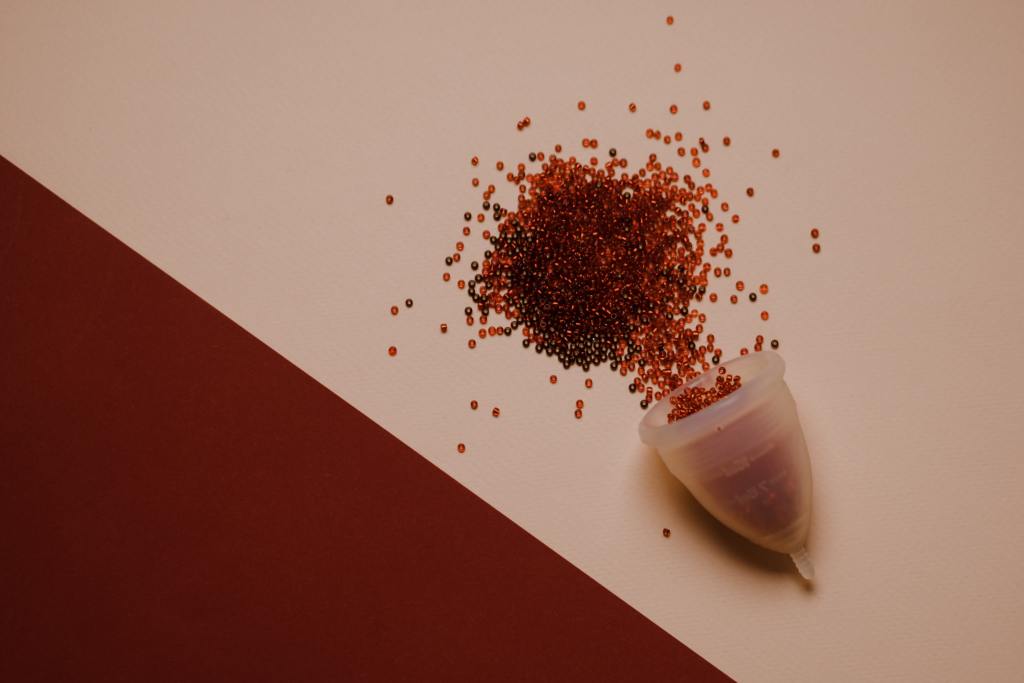One of the latest health trends is staying in sync with your menstrual cycle, but does it really work?
Periods. Menstruation. These word strike fear into the hearts of school boys (at least, it did at my school) and despite approximately 50% of the world’s people having them on a regular basis, there are still many misconceptions and misunderstandings out periods and menstrual cycles.
Thankfully, things are slowly but surely changing. First of all, adverts for some menstrual products are now showing red liquid instead of blue! Second, the British ‘tampon tax’ was abolished in 2021, which means menstrual products no longer have value added tax (VAT) added to their price and they’re no longer considered to be a ‘luxury’.
But let’s look at another rising menstrual trend – cycle syncing.
Let’s go back to basics

Before we go into the finer details of what syncing with the menstrual cycle means, let’s take a look at the cycle itself.
Days 1–7
The day your period starts is the day of a new menstrual cycle, which we’ll call Day 1. Periods typically last 3 to 5 days, but some people experience lengthier bleeding times of up to 7 days. This is also the start of the follicular phase, which covers the first half of the overall menstrual cycle.
Days 8–13
At this point, your period is over and your body is getting ready to ovulate. Oestrogen/estrogen levels are rising, as are follicle stimulating (FSH) and luteinising hormones (LH), as egg follicles in the ovaries start to develop and the uterine wall starts to thicken again.
Day 14
This is typically when ovulation happens. An egg (sometimes two) is released from an ovary into the fallopian tubes. If sperm as present around this time after sexual intercourse or insemination, then this is the time when conception happens.
Fun fact: some women can actually feel when they ovulate! If you feel a pinging pain near where one of your ovaries is at this time of your cycle, then you may be experiencing Mittelschmerz (German for ‘middle pain’).
Days 15–28
We’re now in the luteal phase of the cycle. Oestrogen, FSH and LH levels drop, and progesterone rises before also falling. When this drop happens, it means your period is about to start.
It’s at this point in the cycle that women report common pre-menstrual symptoms like bloating, tender breasts, mood changes and hunger changes. Then, when your period starts, we’re back on Day 1.
What’s the idea behind cycle syncing?

Cycle syncing is a relatively new idea from about 2014, but it really came into its own in 2022 and into 2023. In fact, searches for cycle synching have gone up by 1000% since last year!1 We already know that the menstrual cycle can affect many aspects of our lives, from physical symptoms to our moods. So, the basic idea is that we live our lives in a monthly cycle that works in harmony with our natural bodily changes.1–3
The two biggest aspects of cycle synching, as with so many other trends, are mostly based around diet and exercise. Advocates will claim that by living in sync with your menstrual cycle, you’ll experience benefits such as:1–3
- Improved energy levels
- More effective workouts
- Balanced moods
First things first, you need to know your cycle

If you want to give cycle synching a go, then you need to know what your cycle looks like. 28 days is the average length of a menstrual cycle, but there will always be a couple of days variation from month to month, and the range is from 21 to 35 days.
The old school method of tracking is putting pen to paper with a diary or calendar. Nowadays, there are more menstrual tracking apps that you can shake a stick at so I recommend downloading and using one if you haven’t already.
Next, match your movements

In my research (more on that later), I’ve found that these exercises are recommended for different phases of your menstrual cycle:2,3
Days 1–7
Focus on gentle stretching such as yin yoga and easy going pilates, as well as light cardio such as walking.
Days 8–14
Your energy levels will have recovered, so advocates recommend engaging in high energy workouts such as HIIT, Zumba, swimming and running.
Days 15–28
As progesterone levels rise, now is the time to do some strength training and more intense forms of yoga and pilates.
Finally, optimise your cycle nutrition

Okay, here’s the big one: food. Now, we know that our hunger levels and cravings can change, particularly before a period starts, but what about the rest of the cycle? Well look no further, here are the recommendations I’ve found online:2,3
Days 1–7
Focus on comforting foods that will replenish depleted iron stores e.g. lentil soups with kale, eggs (whichever way works for you) and dark chocolate. You’ll also want vitamin C rich foods like vegetables and citrus fruits to help with iron absorption, and healthy fats from sources like salmon and avocados.
Days 8–14
As oestrogen levels rise, foods like pumpkin seeds and flax are recommended to level out hormones. You’ll also want to focus on whole grains, and continue to eat healthy sources of proteins and fats as you reach ovulation.
Days 15–28
At this point, you’ll want foods that support progesterone production. This involves magnesium and zinc rich foods like nuts and seeds, healthy fats and carbohydrates that won’t cause spikes in blood sugar levels.
(Note: there are huge lists of foods available on this subject, see the footer below for more information.)
What are the pros and cons of cycle syncing?

As I said earlier, cycle synching is a trend that has exploded in popularity1 – just check Instagram and TikTok to see how ‘what I eat in a day’ influencers have shifted to ‘what I eat during my menstrual cycle’. But, is cycle syncing all it’s cracked up to be? Let’s delve a little deeper.
It raises awareness of female health
Not everyone receives helpful and useful information about their menstrual cycle, so the fact that social media has picked up this trend and is advocating the open talk of menstrual health is great. It’s a subject that shouldn’t be talked about behind closed doors with our mums, or whispered amongst friends in fear that someone will overhear you.
Ultimately, menstruation isn’t something to be ashamed of. It happens regularly, and it’s part of the human experience. It needs acceptance and understanding.
It simplifies female health
Conversely, I can’t help but feel like cycle synching is simplifying female health. First of all, it’s focusing on food and fitness and has framed these two important lifestyle factors as the be all and end all of menstruation. We know, however, that menstruation isn’t always regular and straightfoward.
Some people suffer from life altering conditions such as polycystic ovaries and endometriosis, or abnormally heavy periods that leave them with dangerously low iron levels. These are conditions where food and exercise can easily go out of the window due to the pain and inconvenience of symptoms. What’s more, they’re conditions that need help from informed and qualified professionals.
Finally, cycle syncing completely ignores people on hormonal birth control. If you’re not ovulating, or not experiencing a monthly bleed, then can you really get in sync with a cycle?
It encourages self care in manageable ways
Food and exercise are two lifestyle changes that can be made on your own terms. For example, you don’t need to sign up to an expensive yoga class to get started with stretching as you can find that information online. And while you may not be able to implement every single dietary change that’s recommended above, you can use this knowledge to make changes e.g. incorporating healthy fats into meals or combining iron rich foods with vitamin C.
I will note this however, iron is needed throughout your menstrual cycle as it takes several weeks to make new red blood cells that are iron rich – so don’t just focus on iron rich foods during your period.
It’s lacking credible research… for now
I hinted at this earlier. I struggled to find credible, peer reviewed studies of cycle syncing. Menstruation and nutrition was particularly lacking, and a lot of studies and analyses that I found were focused on athletes, rather than regular members of the public. When I did find papers, they always made an opening point that female focused scientific research is lacking, which is never a good sign.4,5
One paper that I did find, again in an analysis of athletes, found that performance was ‘trivially reduced’ during the early follicular phase… which goes against everything else I’ve read in online articles.6
Ultimately, this lack of research is a real shame as cycle synching runs the risk of falling into the hands of snake oil sales people who will peddle false and potentially dangerous advice.
Let’s hope that as female health becomes more and more mainstream, researchers take note and decide to invest the time and research into this area. Women and people who menstruate desperately need further, credible insights to improve our health.
Thanks for reading. Sign up to Pandora’s Health to for even more advice, tips and tricks about the latest trends.
References:
- Glossy. Is cycle synching the new wellness frontier?
- Simply Health. How to cycle sync your workouts.
- So Fresh So Green. Hormone-Balancing Foods To Eat For Each Phase Of Your Menstrual Cycle.
- Rogan MM & Black KE. Nutrition Reviews. 2022; 0(0):1–18.
- WohlgemuthKL, et al. J Int Soc Sports Nutr. 2021;18(27):1–20.
- McNulty KL, et al. Sports Med. 2020; 50(1):1813–1827.

